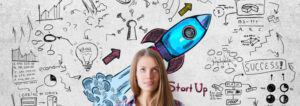How can HR foster innovation in your organisation?
- 8 Min Read
Creativity fosters innovation, and innovation drives growth, but how can human resource professionals create an environment that allows both to flourish? HRD Connect outlines why innovation is so important and how to cultivate a company culture that helps it thrive.
- Author: HRD Connect
- Date published: Nov 28, 2018
- Categories

 In business, innovation drives growth. The economist Joseph Schumpeter described innovation as a form of ‘industrial mutation’ which ‘incessantly revolutionises the economic structure from within’ destroying the old and replacing it with the new. History is scattered companies died out because they failed to change with the times, often destroyed by new entrants to the market that possessed what is arguably most important, yet most intangible of assets a business can claim to hold – innovation.
In business, innovation drives growth. The economist Joseph Schumpeter described innovation as a form of ‘industrial mutation’ which ‘incessantly revolutionises the economic structure from within’ destroying the old and replacing it with the new. History is scattered companies died out because they failed to change with the times, often destroyed by new entrants to the market that possessed what is arguably most important, yet most intangible of assets a business can claim to hold – innovation.
The thing is that innovation can come from anywhere. It can come from any department or person within a company, but without a culture in place that allows transformative voices to be heard this key ingredient for growth will not flourish and rather than thrive, a business will likely die.
Innovation for growth
Innovation is the lifeblood of any business, with companies constantly looking for creative new products and services to drive growth, but how does a company create a culture of innovation?
For some experts the key to creating a culture of creativity is inclusion. ‘It’s about everybody in the organisation contributing their ideas to the future success of the organisation and most employees have got an idea about how to do something better than their managers do,’ explained John McGurk, a learning and development adviser for the Chartered Institute of Personnel and Development (CIPD) in a recent CIPD podcast.
‘Most employees keep it to themselves in most organisations because they don’t feel as if it’s invited and it’s about tapping that employee potential and that’s where I think HR’s got a critical role to play,’ he added.
HR professionals, therefore, should aim to create a company culture that makes outside the box thinking the norm and to do that it is essential for the company to have an outside the box culture. To make this a reality, HR professionals must not only hire top talent, but actively nurture their employees to be engaged with the company they work for and foster a relaxed working environment that gives staff the time, space and power to speak freely. An HR department that succeeds in ticking all these boxes will be able to reach the holy grail of innovation.
Now that we have defined how important it is to foster innovation in an organisation and that the key to doing that is by defining a company culture that not only attract top talent to the business but one that allows those employees the freedom to create, its essential to find scaffolding with which to embed creativity across an organisation.
For McGurk, collaboration and capability – the two C’s – are two essential building blocks for fostering innovation in any organisation.
‘When you think about collaboration it’s all about having an organisational design and structure that allows people to collaborate, that identifies who the key and critical people are, make sure that teams aren’t just cliques or specialists, and that they bring in different insight, they bring in different perspectives,’ he said.
‘And it’s also about capability. It’s about saying, ‘Do we have the skills to do this and what skills do we need to build in the team?’ It’s not always about bringing people in, it might be about actually, we could do with creating some facilitation skills so that we can have decent brainstorming sessions. It might well be about specific technical skills like computer programming and stuff like that.’
Growing culture
For a fledgling company just starting out it is an easier task to tailor and control the culture within the business because the team is often made up of just a few people, often brought together with a common goal. But as a business thrives one of the biggest challenges it faces is maintaining the innovative culture that made it a success in the first place.
One company that knows all too well about how difficult it is to keep creativity flourishing in a rapidly expanding business is Groupon. The US-based online deals site was launched a decade ago but experienced a meteoric rise in less than 18 months of doing business, with the company breaking $1 billion in sales. The start-up became a company boasting a multi-billion-dollar valuation on track to go public in a matter of three years. And such gargantuan growth required the company to increase its headcount just as fast. Former HR Director at Groupon Hailey Wojcik recalls in the CIPD podcast how the company grew from a team just two after just a year of trading to a business with more than 800 people by 2012 – a move that was necessary, but one that required a lot of creativity to make it a success.
‘We needed to be innovative, not only in our product side, so what we’re doing for merchants and our customers, but also on the people side of things and when I say that it’s because half of our company really is in start-up mode,’ explained Wojcik. ‘These people joined us to be entrepreneurial, to be cowboy, because that side of it appealed to them, but then, as we’ve continued to grow, and our landscape of people has changed, we had to introduce into the organisation people who were looking for a stable, long-term career, looking to come into an established organisation.’
This unique composition required Wojcik and her team to conduct a balancing act, which catered for the needs of those that joined the company when it was just a start-up and those that joined now that the company had grown to become global brand listed on the NASDAQ with a billion-dollar-plus valuation. The key challenge was finding a way to create an innovative company culture that can engage both groups and not alienating one or the other. To get it right required a lot of trial and error, with Wojcik and her team throwing a lot of ideas around, executing them, keeping parts that worked and binning those that failed. ‘The test run for us is super important,’ she explained. ‘So basically, what should we keep, what should we improve and what should we cut right out of it.’
‘And using that and taking in the feedback is really how we are able to continue to innovate because we’re taking the basic ideas that are there but then incorporating in the feedback from our organisation and when you’re involving people in the change, regardless if it’s big or small, once you have the buy-in from them pushing through that innovation and encouraging them to continue to give their ideas and continue to be creative, it’s much easier because we’ve already set the pace as to this is what they’re able to do within the company,’ she added.
This formula of feedback and willingness to try new things is what helped fuel creativity in the workplace and ultimately drive growth through innovation for the company itself. But for all the lessons that can be learned from Groupon, its most important comes not from its success but where it has floundered in more recent years.
This summer, the company’s management team announced that it is putting the company up for sale after its revenues declined by around 17% in the first quarter of 2018 and its share price has steadily declined from around $25 a share back in 2012 to under $5 per share today. The company was once one of the darlings of the tech industry, with it valued at more than $16 billion when it launched its IPO in 2011, which it owed to its innovative beginnings. But for all its creativity and success, Groupon’s steady decline is a reminder of how hard innovation is to maintain.
Innovation failure
Innovation drives growth, but to remain competitive in any market requires creativity to be tempered by efficient operational practices. A company can create incredible products, but if it overspends, runs out of capital, or is unable to drive sales then a company will fail to turn a profit and it will die. And here lies a major conundrum worth solving.
The type of thinking that makes a company sustainable and profitable is often a death nail to innovation. It is why many of the world’s top tech companies have established separate innovation units like IBM Research and Google X. Places that are not confined to the same obsession of profit and loss, but rather trial and error, creativity and innovation.
If HR professionals are to inspire outside the box thinking within their organisation they must try to do similar too. And despite the very real need to keep employee productivity high and maximise various other HR metrics that will ensure good operational practices, it is also essential to temper that rigidity with flexibility and freedom. Because a company that doesn’t allow its employees time and space to think or take risks will eventually lose the very thing that made everything else possible – innovation.






